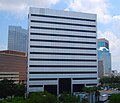The firm designed 17 of the city's 30 tallest buildings and "created Jacksonville's modern skyline", according to The Florida Times-Union . [2] The firm designed the first high-rise in downtown Jacksonville, the 22-story Aetna Building, which opened in 1955. [5]
Duval County Courthouse
In June 2002, KBJ Architects, Rink Reynolds, Cannon Design, and Spillis Candela were the final four candidates under consideration for designing the planned Duval County Courthouse Complex. [17] When Cannon Design was chosen, KBJ appealed the award, claiming that Cannon's design was inconsistent with the specifications for size and budget set by the city, but the administration of Mayor John Delaney saw no grounds for the award to be rescinded. The project continued under Cannon into the term of Mayor John Peyton, but costs and the size of the project fluctuated and ultimately peaked at a $224 million construction cost, $23 million over the $201 million Mendoza Line for construction costs drawn by the Mayor. As a result, Peyton stopped all work on the project and terminated all consultants contracts for convenience, including Jacobs Facilities (Program Manager), Cannon (Architect), and construction managers Skanska Dynamic Partners. [17]
The project was re-bid in 2006, and the city received two offers for a Design-Build solution and project delivery. The team of Perry-McCall Construction -The Auchter Company coupled with Architects Rink Design and DLR were initially awarded the contract. [18] When it was discovered that the Auchter Company had financial troubles, the contract was terminated for convenience. Second place bidder, Turner Construction Company, which is partnered with Technical Construction Services Group and KBJ Architects, was given an opportunity to negotiate a contract with the city in July 2007, by approval of the Competitive Sealed Proposal Evaluation Committee. A contract was signed with a budget of $350 million. Work was completed and the courthouse opened on June 18, 2012. [19]
















